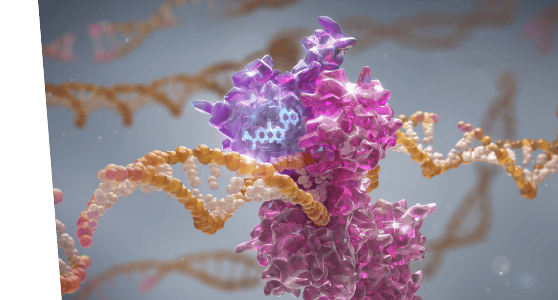LYNPARZA® (olaparib), a targeted poly (ADP-ribose) polymerase (PARP) inhibitor, is helping change the lives of many patients with cancers with certain DNA damage response (DDR)‑related mutations
AstraZeneca’s corporate mission is to eliminate cancer as a cause of death by following the science and pushing boundaries.
As the first FDA-approved PARP inhibitor, the approval of LYNPARZA was accompanied by an increase in the use of biomarker testing in treatment decision making.1
Targeted therapies are cytotoxic to cancer cells with‑specific mutations, such as those in genes involved in the DNA damage response (DDR) pathway. PARP inhibitors treat tumors with homologous recombination deficiency (HRD), such as certain ovarian, breast, and prostate cancers by targeting PARP, a family of proteins that is essential for DNA repair.2-4
HRD/genomic instability and genetic mutations in homologous recombination repair (HRR) pathways, including BRCA1 and BRCA2, are often associated with various ovarian, breast, and prostate cancers and, in cases of breast and prostate cancer, often indicate more aggressive disease.5-7


The development of targeted drugs for people with mutations like mine has made a huge difference, because companies like AstraZeneca have invested in developing a drug that works to leverage my mutation.”
– Susan, gynecologic
cancer patient
*Susan is a real patient and has received compensation from AstraZeneca for her participation.



Redefining cancer care for ovarian patients
Dr Bradley Monk highlights his experience with LYNPARZA, the impact that its had on his patients and the clinical community, as well as future directions.
Transcript
Approaching care for breast cancer patients
Dr Priyanka Sharma discusses how the results of OlympiAD and OlympiA led to the approval of LYNPARZA for BRCA-associated breast cancers as well as the associated impacts on genetic testing in clinical practice.
Transcript
A personalized approach to prostate cancer
Dr Eleni Efstathiou discusses how the results of PROfound and PROpel have impacted her clinical practice by allowing her to take a personalized and targeted approach utilizing PARP inhibition to treat men with BRCAm and HRR gene-mutated mCRPC.
Transcript
AstraZeneca is delivering precision medicine to help improve outcomes across the DDR pathway
As the first PARP inhibitor, LYNPARZA’s 2014 FDA approval was a significant milestone for patients with advanced ovarian cancer with BRCA1/2 mutations, a patient population in need of options for maintenance therapy to help delay disease progression.4,13,14
Since then and spanning over the last decade, LYNPARZA has expanded its indications across certain types of ovarian, breast, prostate, and pancreatic cancers.4
AstraZeneca’s approach to treating these cancers is broader than selecting patients based on mutations in BRCA1/2 genes. LYNPARZA’s indications in ovarian cancer also include patients with HRD, as defined by a BRCA mutation and/or genomic instability, and one of LYNPARZA’s indications in prostate cancer include patients with other HRR gene mutations.4

Having this diagnosis doesn’t have to be the worst thing that can happen. We can turn these struggles into successes through our journey of becoming more knowledgeable and opening ourselves up to the idea that there are so many good things in life. I have my bad days as well, but I know how to put that big stop sign up when I’m starting to feel low. And for me, life is good, and LYNPARZA has given me more time, and I'm very grateful.”
– Paul, prostate cancer patient
*Paul is a real patient and has received compensation from AstraZeneca for his participation.


LYNPARZA is currently approved for the following tumor types:4
- Maintenance treatment of BRCAm advanced or recurrent ovarian cancer and in combination with bevacizumab for maintenance treatment of HRD+ advanced ovarian cancer
- Treatment of gBRCAm HER2– metastatic and high-risk early-stage breast cancers
- Maintenance treatment of gBRCAm metastatic pancreatic cancer
- Treatment of HRRm metastatic castration-resistant prostate cancer (mCRPC) and treatment of BRCAm mCRPC in combination with abiraterone and prednisone or prednisolone
Please see below for full indications and select patients for therapy based on an FDA-approved companion diagnostic for LYNPARZA.
Select Safety Information
LYNPARZA is associated with serious and potentially fatal adverse events including myelodysplastic syndrome/acute myeloid leukemia (MDS/AML), pneumonitis, and venous thromboembolism (VTE). Monitor patients for signs and symptoms and discontinue LYNPARZA if MDS/AML or pneumonitis is confirmed. Monitor patients for signs and symptoms of VTE and treat as medically appropriate. LYNPARZA can cause fetal harm.
Please see below for additional Important Safety Information.
AstraZeneca is committed to treating patients with cancer by advancing knowledge of the DDR pathway in oncology
Once a novel biologic agent, PARPis have become a standard of care in certain cancers with HRD or HRR mutations.15-17
AstraZeneca is exploring different approaches to identify patients likely to respond to LYNPARZA, including different markers of HRR deficiency. In efforts to tackle emerging resistance and achieve more durable responses, the effects of DDR inhibitor combinations, including those with other targeted therapies, are also being explored.
For more information regarding how AstraZeneca is combatting cancer by exploiting the DDR pathway, please visit the AstraZeneca US corporate website.
10 years of LYNPARZA, a targeted therapy for certain tumor types
Throughout multiple randomized clinical trials, LYNPARZA has demonstrated efficacy across four different tumor types. See a milestone overview of LYNPARZA’s clinical trial development program and associated approvals based on an enhanced understanding of the DDR process and PARP inhibition.
MOVE THE TIMELINE
The LYNPARZA 10 Year Journey
An exploration of key scientific milestones
Over 20 years ago, scientists discovered that deficiencies in the DNA damage response (DDR) process known as homologous recombination repair (HRR), resulting in homologous recombination deficiency (HRD), were an Achilles heel for certain cancers.1
The HRR protein complex includes genes such as BRCA1, BRCA2, and others. When these genes acquire certain mutations, HRR is defective, leading to wide-spread chromosomal structural changes. This accumulation of chromosomal variants is also known as genomic instability.2,3
Growing interest in targeting the DDR pathway led to the development of LYNPARZA, the first approved poly (ADP-ribose) polymerase (PARP) inhibitor, which targets PARP enzymes involved in DNA repair in patients with HRD, resulting in defective DNA damage repair and cancer cell death.4,5,6
The FDA approvals of LYNPARZA for various indications were accompanied by the approvals of several tumor-specific companion diagnostic tests to help select appropriate patients for LYNPARZA (BRACAnalysis CDx; FoundationOne®CDx; Myriad MyChoice CDx).5,7
Clinical Pipeline
For more information on LYNPARZA, please see Important Safety Information below and view the Prescribing Information.
Perscribing Information
BRCA, breast cancer susceptibility gene; CDx, companion diagnostic; CI, confidence interval; DDR, DNA damage response; DOR, duration of response; FDA, US Food and Drug Administration; HR, hazard ratio; HRD, homologous recombination deficiency; HRR, homologous recombination repair; IDFS, invasive disease-free survival; ITT, intention-to-treat; mBC, metastatic breast cancer; mCRPC, metastatic castration-resistant prostate cancer; ORR, objective response rate; OS, overall survival; PARPi, poly (ADP-ribose) polymerase inhibitor; PFS, progression-free survival; rPFS, radiological progression-free survival; TFST, time to first subsequent therapy or death.
References
AstraZeneca’s mission is to redefine cancer care and contribute to advances in precision medicine within the oncology landscape. There is always more to be done to deliver the right medicine for the right patient at the right time.
By increasing testing rates, particularly for DDR-related gene mutations/markers of genomic instability, the oncology community has an opportunity to leverage predictors of treatment response.
The expanded use of biomarker testing as well as further advancements in cancer diagnostics will allow more patients with cancer to be identified for potential targeted therapies.
AstraZeneca continues to push the boundaries of technology and science and is currently studying LYNPARZA in additional tumor types and in combinations with other agents.
References
- Chastek B, Bunner S, Simmons D, et al. Real world trends in biomarker testing in US advanced ovarian cancer patients. Gynecol Oncol. 2021;162(supp 1): S256-S257.
- Ashworth A. A synthetic lethal therapeutic approach: poly (ADP-ribose) polymerase inhibitors for the treatment of cancers deficient in DNA double-strand break repair. J Clin Oncol. 2008;26(22):3785-3790.
- O’Connor MJ. Targeting the DNA damage response in cancer. Mol Cell. 2015;60:547-560.
- LYNPARZA® (olaparib) [prescribing information]. Wilmington, DE: AstraZeneca Pharmaceuticals LP; 2023.
- Petrucelli N, Daly MB, Pal T. BRCA1- and BRCA2-associated hereditary breast and ovarian cancer. In: Adam MP, Feldman J, Mirzaa GM, et al., editors. GeneReviews®. University of Washington. Updated September 21, 2023. https://www.ncbi.nlm.nih.gov/books/NBK1247/
- Mitra A, Fisher C, Foster CS, et al. Prostate cancer in male BRCA1 and BRCA2 mutation carriers has a more aggressive phenotype. Br J Cancer. 2008;98(2):502-507.
- Lozano R, Castro E, Aragón IM, et al. Genetic aberrations in DNA repair pathways: a cornerstone of precision oncology in prostate cancer. Br J Cancer. 2021;124:552–563.
- Konstantinopoulos PA, Ceccaldi R, Shapiro GI, D’Andrea AD. Homologous recombination deficiency: exploiting the fundamental vulnerability of ovarian cancer. Cancer Discov. 2015;5(11):1137-1154.
- Cancer Genome Atlas Research Network. Integrated genomic analyses of ovarian carcinoma. Nature. 2011;474(7353):609-615.
- American Cancer Society (ACS). Breast Cancer Facts & Figures. 2024. https://www.cancer.org/content/dam/cancer-org/research/cancer-facts-and-statistics/breast-cancer-facts-and-figures/2022-2024-breast-cancer-fact-figures-acs.pdf
- Mateo J, Seed G, Bertan C, et al. Genomics of lethal prostate cancer at diagnosis and castration resistance. J Clin Invest. 2020;130(4):1743-1751.
- Robinson D, Van Allen EM, Wu YM, et al. Integrative clinical genomics of advanced prostate cancer. Cell. 2015;161(5):1215-1228.
- Audeh MW, Carmichael J, Penson RT, et al. Oral poly (ADP-ribose) polymerase inhibitor olaparib in patients with BRCA1 or BRCA2 mutations and recurrent ovarian cancer: a proof-of-concept trial. Lancet. 2010;376(9737):245-251.
- Mirza MR, Coleman RL, González-Martín A, et al. The forefront of ovarian cancer therapy: update on PARP inhibitors. Ann Oncol. 2020;31(9):1148-1159.
- Hasanov E, Pimentel I, Cruellas M, Lewis MA, Jonasch E, Balmana J. Current systemic treatments for the hereditary cancer syndromes: drug development in light of genomic defects. ASCO Educ Book. 2022. doi:10.1200/EDBK_350232
- Tew WP, Lacchetti C, Kohn EC; PARP Inhibitors in the Management of Ovarian Cancer Guideline Expert Panel. Poly (ADP-ribose) polymerase inhibitors in the management of ovarian cancer: ASCO guideline rapid recommendation update . J Clin Oncol. 2022;40(33):3878-3881.
- Tung NM, Zakalik D, Somerfield MR; Hereditary Breast Cancer Guideline Expert Panel. Adjuvant PARP inhibitors in patients with high-risk early-stage HER2-negative breast cancer and germline BRCA mutations: ASCO hereditary breast cancer guideline rapid recommendation update. J Clin Oncol. 2021;39(26):2959-2961.
Abbreviations: BRCA1/2, breast cancer gene 1/2; BRCAm, mutations in BRCA genes; DDR, DNA damage response; FDA, US Food and Drug Administration; HRD, homologous recombination deficiency; HRR, homologous recombination repair; mCRPC, metastatic castration-resistant prostate cancer; PARP, poly (ADP-ribose) polymerase.






